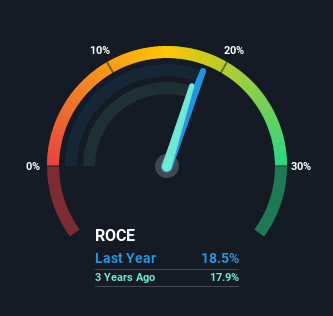- United States
- /
- Food
- /
- NasdaqCM:RMCF
Rocky Mountain Chocolate Factory (NASDAQ:RMCF) Is Finding It Tricky To Allocate Its Capital
When researching a stock for investment, what can tell us that the company is in decline? More often than not, we'll see a declining return on capital employed (ROCE) and a declining amount of capital employed. Ultimately this means that the company is earning less per dollar invested and on top of that, it's shrinking its base of capital employed. On that note, looking into Rocky Mountain Chocolate Factory (NASDAQ:RMCF), we weren't too upbeat about how things were going.
What is Return On Capital Employed (ROCE)?
If you haven't worked with ROCE before, it measures the 'return' (pre-tax profit) a company generates from capital employed in its business. The formula for this calculation on Rocky Mountain Chocolate Factory is:
Return on Capital Employed = Earnings Before Interest and Tax (EBIT) ÷ (Total Assets - Current Liabilities)
0.18 = US$3.9m ÷ (US$27m - US$6.1m) (Based on the trailing twelve months to November 2021).
Thus, Rocky Mountain Chocolate Factory has an ROCE of 18%. In absolute terms, that's a satisfactory return, but compared to the Food industry average of 9.7% it's much better.
Check out our latest analysis for Rocky Mountain Chocolate Factory

While the past is not representative of the future, it can be helpful to know how a company has performed historically, which is why we have this chart above. If you'd like to look at how Rocky Mountain Chocolate Factory has performed in the past in other metrics, you can view this free graph of past earnings, revenue and cash flow.
What Can We Tell From Rocky Mountain Chocolate Factory's ROCE Trend?
There is reason to be cautious about Rocky Mountain Chocolate Factory, given the returns are trending downwards. To be more specific, the ROCE was 28% five years ago, but since then it has dropped noticeably. On top of that, it's worth noting that the amount of capital employed within the business has remained relatively steady. Companies that exhibit these attributes tend to not be shrinking, but they can be mature and facing pressure on their margins from competition. If these trends continue, we wouldn't expect Rocky Mountain Chocolate Factory to turn into a multi-bagger.
What We Can Learn From Rocky Mountain Chocolate Factory's ROCE
In summary, it's unfortunate that Rocky Mountain Chocolate Factory is generating lower returns from the same amount of capital. And long term shareholders have watched their investments stay flat over the last five years. Unless there is a shift to a more positive trajectory in these metrics, we would look elsewhere.
On a final note, we found 3 warning signs for Rocky Mountain Chocolate Factory (1 can't be ignored) you should be aware of.
For those who like to invest in solid companies, check out this free list of companies with solid balance sheets and high returns on equity.
New: AI Stock Screener & Alerts
Our new AI Stock Screener scans the market every day to uncover opportunities.
• Dividend Powerhouses (3%+ Yield)
• Undervalued Small Caps with Insider Buying
• High growth Tech and AI Companies
Or build your own from over 50 metrics.
Have feedback on this article? Concerned about the content? Get in touch with us directly. Alternatively, email editorial-team (at) simplywallst.com.
This article by Simply Wall St is general in nature. We provide commentary based on historical data and analyst forecasts only using an unbiased methodology and our articles are not intended to be financial advice. It does not constitute a recommendation to buy or sell any stock, and does not take account of your objectives, or your financial situation. We aim to bring you long-term focused analysis driven by fundamental data. Note that our analysis may not factor in the latest price-sensitive company announcements or qualitative material. Simply Wall St has no position in any stocks mentioned.
About NasdaqCM:RMCF
Rocky Mountain Chocolate Factory
Produces and sells confectionery products in the United States.
Moderate risk and slightly overvalued.
Market Insights
Community Narratives




